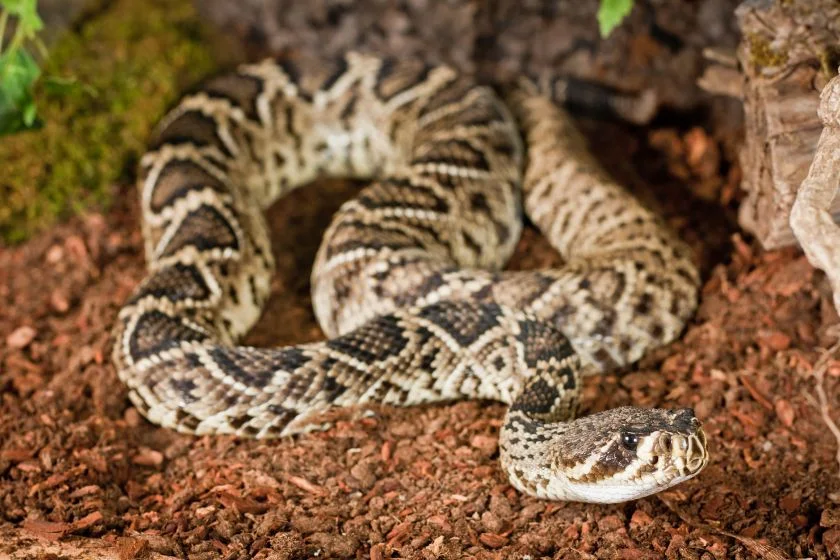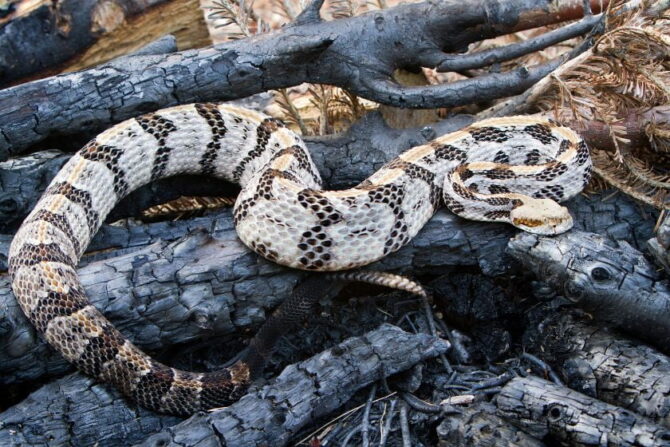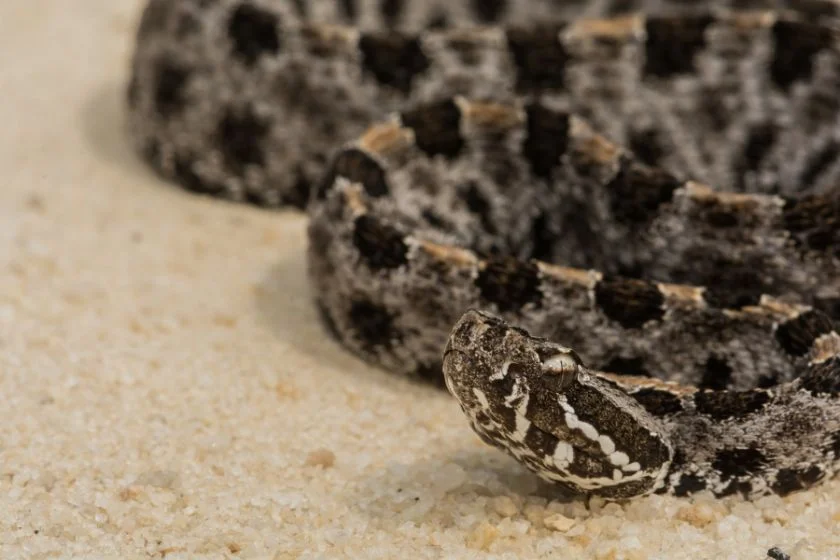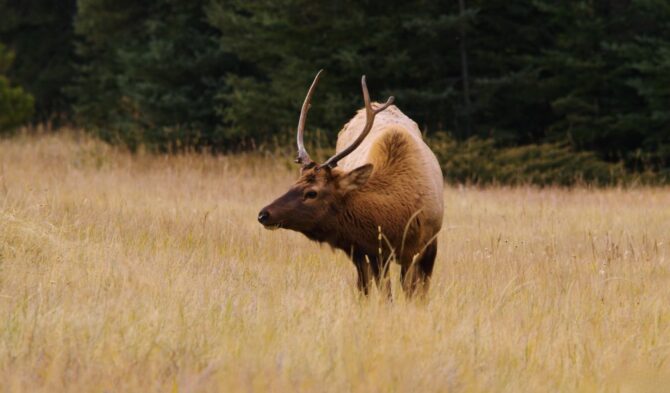With a total of 37 snake species, North Carolina is a fitting land for these reptiles.
The state has the right habitat for animals, like mountains, beaches, grasslands, marshes, and rivers.
This accounts for why there are a lot of snakes in the state. The non-venomous snakes surpass the venomous species, which is good news as it reduces the chances of getting bit.
There are only 6 venomous snakes in North Carolina. These are the cottonmouth, copperhead, timber rattlesnake, diamondback rattlesnake, pygmy rattlesnake, and Eastern coral snake.
Let’s explore each of these poisonous snakes in NC in detail.
The Venomous Snakes in North Carolina
1. Eastern Coral Snake (Micrurus fulvius)

- Size: 31 inches
- Habitat: Glade land, high pine, scrub oak
- Identifying Features: Small, dorsal scales, black head
- Behavior: Solitary, not aggressive, terrestrial
- Threats: Neurotoxin, paralysis, respiration problems, double vision
The Eastern coral snake is also known as the common coral snake and the American cobra.
It can be found only in the United States, specifically in the southeastern areas.
This species is similar to the scarlet snake and the scarlet kingsnake, except that the two species are non-venomous.
The Eastern coral snake is rare in North Carolina, but still worth watching out for.
This species is quite dangerous, though the bite is rarely fatal. The venom contains a neurotoxin that affects both its prey and human victims.
Its mortality rate falls between 5 and 20%, which is still a cause for concern.
When the eastern coral snake bites a human, the person will experience symptoms like double vision, slurred speech, and paralysis.
2. Eastern Copperhead (Agkistrodon contortrix)

- Size: 20 to 37 inches
- Habitat: Deciduous forests, mixed woodlands, swamps, rock outcroppings
- Identifying Features: Broad head, pale tan color, patterns
- Behavior: Nocturnal, lying still
- Threats: Painful bites
The eastern copperhead is found only in North America, specifically on the eastern side.
It is the most common venomous snake in North Carolina, so you should be on the lookout.
It often stays in wooded areas like forests and swamps. Because of its pale tan color, it is good at camouflaging.
This makes it to opt for freezing rather than running away.
Compared to other venomous snakes, the eastern copperhead is regarded as less dangerous.
Its venom isn’t as potent as other pit vipers, and the snake is not very aggressive.
It tends to bite only when stepped on or handled. That being said, it is not a creature to trifle with.
The bite produces symptoms like nausea, swelling, and intense pain.
3. Cottonmouth (Agkistrodon piscivorus)

- Size: 26 to 35 inches
- Habitat: Creeks, streams, swamps, marshes
- Identifying Features: Broad head, black skin, patterns
- Behavior: Opening mouth, shaking tail, both diurnal and nocturnal
- Threats: Cytotoxin, venom yield 125mg, swelling, pain
The cottonmouth is also known as the Northern cottonmouth, the swamp moccasin, the black mocassin, the water moccasin, or simply the viper.
It is a native of the United States and is quite common in North Carolina.
Its main name comes from its gaping behavior. When threatened, the cottonmouth opens its mouth, exposing the white within. It also shakes its tail.
The cottonmouth has a strong venom that contains cytotoxin, a destroyer of tissues.
The bite is always painful and can be fatal, though death from a cottonmouth is rare.
It’s more common for victims to end up in critical conditions. In extreme cases, the bitten part might be amputated.
Cottonmouths aren’t aggressive, however. They warn before striking and only bite when they feel threatened.
4. Eastern Diamondback Rattlesnake (Crotalus adamanteus)

- Size: 7.8 feet
- Habitat: dry pine forests, sandhills, coastal maritime hammocks, salt marshes
- Identifying Features: Large head, bulky, blackish brown, olive or dusty gray color, patterns
- Behavior: Cold-blooded, solitary
- Threats: Long fangs, 400-450 mg venom, crotalase
The eastern diamondback rattlesnake is quite big. At 7.8 feet, it is considered the largest rattlesnake and the largest venomous snake in the United States.
It occurs specifically in the southeastern side. The eastern diamondback rattlesnake is also on the southeastern side of North Carolina and is quite common.
Similar to other rattlesnakes, the eastern diamondback is known for the rattle sound it makes.
This snake’s bite is worse than that of the cottonmouth and the copperhead.
Even more, it is considered the most dangerous venomous snake in North America.
This puts it a league above the aforementioned species. The mortality rate may get up to 30%, but even when the victim survives, the negative effects are numerous.
Symptoms include intense internal pain, bleeding, swelling, and a weak pulse.
5. Timber Rattlesnake (Crotalus horridus)

- Size: 36 to 60 inches
- Habitat: Deciduous forests, mountains
- Identifying Features: Gray color, stripes on the back, pinkish hue
- Behavior: Docile, solitary
- Threats: Hemotoxin, neurotoxin
The timber rattlesnake is one of the most widespread venomous species in North America.
While its main habitat is the deciduous forest, in North Carolina you’d find it on mountains and coastal plains.
The timber rattlesnake likes to camouflage, but it won’t hesitate to shake the rattle when necessary.
Timber rattlesnakes are highly venomous and dangerous. A bite from it can render the victim both paralyzed and short of blood.
The venom contains two deadly substances, the hemotoxin, and the neurotoxin.
Its docile nature makes it less likely to attack, but avoid handling or stepping on it.
6. Pygmy Rattlesnake (Sistrurus miliarius)

- Size: 16 to 24 inches
- Habitat: Flatwoods, mixed forests, floodplains, lakes, marshes
- Identifying Features: dorsal patterns, slim tail with a rattle, diurnal
- Behavior: Nocturnal, solitary,
- Threats: Cytotoxin, painful bite.
The pygmy rattlesnake is the smallest snake on this list. It is also classified as the smallest rattlesnake.
However, it is more dangerous than the cottonmouth and the copperhead.
It stays more in wooded areas but not at the exclusion of other habitats like lakes and marshes.
Despite the size, the pygmy rattlesnake should be avoided. This is especially true if you have kids in your company.
Many children pick up the snake, thinking it is harmless until it strikes. It affects the victim’s tissues and even causes bleeding.
Final Thoughts
Be careful and watch out for these six venomous snakes in North Carolina.
As a general rule, be careful around snakes, especially if you’re not sure whether the creature is venomous or non-venomous.
Some non-venomous species can pose risks as well.
If you’re exploring an area that may have snakes, be sure to watch your steps and wear boots that a snake can’t bite into.
Consider every biting case as an emergency, even if no symptoms have shown.
Next Up…
- 10 Most Dangerous Animals In North Carolina (Watch Out)
- 15 Most Dangerous Animals In The United States






